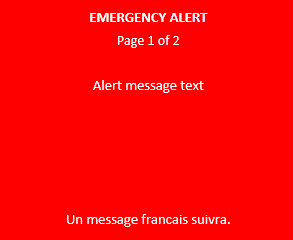Alert Ready Frequently Asked Questions
Alert Ready is Canada’s national emergency alert system. Alert Ready aims to benefit all Canadians by notifying them immediately of potentially life-threatening events. Alert Ready delivers alerts to the public by radio, cable and satellite television, websites and to compatible wireless devices.
Manitoba Emergency Management Organization (EMO) and Environment and Climate Change Canada (ECCC) issue alerts for Manitoba.
- ECCC issues weather alerts.
- Manitoba EMO issues all other alerts based on information from Government of Manitoba agencies and local authorities.
Your feedback is important to us and will assist in improving the Manitoba Emergency Alerting Program. Complete an Emergency Alerting Feedback Form.
Most commonly, alerts are issued for severe weather such as tornadoes, thunderstorms and floods.
Alerts can also be issued for other event types including:
- fire (urban, wildfire)
- natural (tornado, flash flood)
- biological (chemical, drinking water)
- hazardous (explosive)
- environmental (air quality)
- terrorist (violent threats)
- civil (AMBER alert, animal danger)
- administrative (test messages)
Two types of alerts can be issued:
- Broadcast Immediate Alerts are for situations of the highest levels of severity, urgency and certainty with an imminent or expected threat to life safety. These alerts interrupt the broadcasting stream and go straight-to-air as quickly as possible.
- Advisory Alerts are informational in nature, advising the public to be prepared and aware of a potential hazard. Distribution of these alerts by television and radio broadcasters are optional, and may be included in on-air news stories or posted on websites.
Emergency alerts, on radio, television and compatible wireless devices, begin with a distinct sound, known as the Canadian Alert Attention Signal. Hear the Alert Attention Signal.
Radio and television emergency alerts will be followed by an automated message with the emergency alert details of the potential threat. On television, the emergency alert details will be presented either as a full screen or a crawler section at the bottom of the screen.
.
Emergency alerts are sent via Canadian radio, cable and satellite television, and on compatible wireless devices connected to an LTE network.
How the alert is displayed is set by television broadcasters or cable/satellite distributors. Alerts displayed on television should include a visual display of the alert text. Usually, it's a full screen with a red background and white text or a crawler with a red background and white text. Manitoba EMO suggests that you contact the television broadcaster of the channel you were watching or your satellite/cable distributor to express your concerns.
Radio and television broadcasters, and wireless service providers are only required to distribute Broadcast Immediate alerts for situations that pose an immediate threat to life safety.
The information in Advisory alerts - those with lower levels of severity, urgency, and certainty - may be included in news updates, posted to websites, distributed through email and text message services, etc. Advisory alerts make up the vast majority of alerts issued in Manitoba.
No. You will only receive alerts on local television and radio stations.
No, alerts will be broadcast without subscriptions at no cost.
Alerts will be issued only to the affected regions or areas in Manitoba. However, some alerts could be issued province-wide or could affect more than one region. The system geographically targets alerts to limit over alerting.
The system cannot be used to interrupt television or local radio once the danger has passed. However, it is expected the information will continued to be distributed through the media and news programs to update the public.
- All alerts issued in Canada during the past 48 hours can be accessed through an RSS feed available at http://rss.naad-adna.pelmorex.com.
- Several companies offer services such as email or text message alerts. If you receive alerts through these services, you can refer to these emails or text messages when looking for past alerts.
Absolutely! Please refer to the NAAD System – Last Mile Distributor Guide. This guide explains how to access free emergency alerting feeds.
Absolutely! Manitoba EMO issues two types of test alerts intended for broadcast – Broadcast Immediate test alerts and Advisory test alerts. If you would like to schedule an Advisory test alert, please contact us.
The test message policy and the schedule for Broadcast Immediate test alerts are available on the Pelmorex website.
When you hear or see an alert pay attention and take action right away to keep you and your family safe. Alerts will provide instructions on what to do or where to get more information.
Visit the Preparedness section of this website on how to prepare for emergencies in Manitoba.
No. The alert will provide instructions on what to do or where to get more information.


